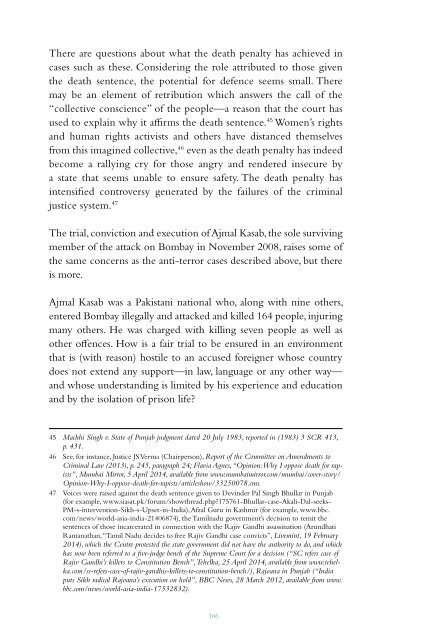PENALTY
DBk0302s7Xm
DBk0302s7Xm
You also want an ePaper? Increase the reach of your titles
YUMPU automatically turns print PDFs into web optimized ePapers that Google loves.
There are questions about what the death penalty has achieved in<br />
cases such as these. Considering the role attributed to those given<br />
the death sentence, the potential for defence seems small. There<br />
may be an element of retribution which answers the call of the<br />
“collective conscience” of the people—a reason that the court has<br />
used to explain why it affirms the death sentence. 45 Women’s rights<br />
and human rights activists and others have distanced themselves<br />
from this imagined collective, 46 even as the death penalty has indeed<br />
become a rallying cry for those angry and rendered insecure by<br />
a state that seems unable to ensure safety. The death penalty has<br />
intensified controversy generated by the failures of the criminal<br />
justice system. 47<br />
The trial, conviction and execution of Ajmal Kasab, the sole surviving<br />
member of the attack on Bombay in November 2008, raises some of<br />
the same concerns as the anti-terror cases described above, but there<br />
is more.<br />
Ajmal Kasab was a Pakistani national who, along with nine others,<br />
entered Bombay illegally and attacked and killed 164 people, injuring<br />
many others. He was charged with killing seven people as well as<br />
other offences. How is a fair trial to be ensured in an environment<br />
that is (with reason) hostile to an accused foreigner whose country<br />
does not extend any support—in law, language or any other way—<br />
and whose understanding is limited by his experience and education<br />
and by the isolation of prison life?<br />
45 Machhi Singh v. State of Punjab judgment dated 20 July 1983, reported in (1983) 3 SCR 413,<br />
p. 431.<br />
46 See, for instance, Justice JS Verma (Chairperson), Report of the Committee on Amendments to<br />
Criminal Law (2013), p. 245, paragraph 24; Flavia Agnes, “Opinion: Why I oppose death for rapists”,<br />
Mumbai Mirror, 5 April 2014, available from www.mumbaimirror.com/mumbai/cover-story/<br />
Opinion-Why-I-oppose-death-for-rapists/articleshow/33250078.cms.<br />
47 Voices were raised against the death sentence given to Devinder Pal Singh Bhullar in Punjab<br />
(for example, www.siasat.pk/forum/showthread.php?175761-Bhullar-case-Akali-Dal-seeks-<br />
PM-s-intervention-Sikh-s-Upset-in-India), Afzal Guru in Kashmir (for example, www.bbc.<br />
com/news/world-asia-india-21406874), the Tamilnadu government’s decision to remit the<br />
sentences of those incarcerated in connection with the Rajiv Gandhi assassination (Arundhati<br />
Ramanathan, “Tamil Nadu decides to free Rajiv Gandhi case convicts”, Livemint, 19 February<br />
2014), which the Centre protested the state government did not have the authority to do, and which<br />
has now been referred to a five-judge bench of the Supreme Court for a decision (“SC refers case of<br />
Rajiv Gandhi’s killers to Constitution Bench”, Tehelka, 25 April 2014, available from www.tehelka.com/sc-refers-case-of-rajiv-gandhis-killers-to-constitution-bench/),<br />
Rajoana in Punjab (“India<br />
puts Sikh radical Rajoana’s execution on hold”, BBC News, 28 March 2012, available from www.<br />
bbc.com/news/world-asia-india-17532832).<br />
This problem is not unique to Kasab; it is uncomfortably common,<br />
but only the politically explosive cases seem to reach the public eye,<br />
and this needs the attention of the international community.<br />
That Kasab was put through the “ossification test” to establish<br />
whether or not he was a juvenile should worry those watching the<br />
use of the death penalty. The effects on the trial of the publicity<br />
surrounding the case—the crime occurred in public, and parts of<br />
his involvement were aired in the media, which raised the pitch of<br />
public disapprobation—have yet to be fully understood. The case<br />
presents a range of traditional fair-trial concerns, including legal<br />
assistance and representation, defence access to documents, and language<br />
barriers. 48<br />
Clemency jurisdiction<br />
The Indian Constitution gives the executive, acting through the President<br />
(Article 72) or the governor of a state (Article 161), the power<br />
to commute the death sentence. The power has in recent times been<br />
used to reject mercy petitions, clearing the way for executions. 49 The<br />
Supreme Court has stepped in and, essentially accepting the ground<br />
of delay, reduced the sentences from death to life. 50 In the meantime,<br />
the record raises questions about how clemency is exercised. Bandu<br />
Baburao Tidake’s death sentence was commuted by the President on<br />
2 June 2012—but he had been dead since 18 October 2007; “the<br />
report about his death apparently did not reach the Home Ministry<br />
when it recommended his commutation.” 51 No guidelines apply to<br />
48 Mohammed Ajmal Kasab v. State of Maharashtra in judgment dated 29 August 2012, available<br />
from http://supremecourtofindia.nic.in/outtoday/39511.pdf. See also Ritesh K. Srivastava, “Legal<br />
aid for Kasab?”, Zee News, available from http://zeenews.india.com/MumbaiTerror/story.aspx-<br />
?aid=498251; V. Venkatesan, “Gaps in Kasab case”, Frontline, 3-16 November 2012, available<br />
from www.frontline.in/static/html/fl2922/stories/20121116292203700.htm.<br />
49 Bharti Jain, “President rejects mercy pleas of Nithari killer, 5 others”, Times of India, 19 July<br />
2014.<br />
50 Shatrughan Chauhan v. Union of India judgment dated 21 January 2014, reported in (2014) 3<br />
SCC 1; T. Suthendra Raja @ Santhan v. Union of India in judgment dated 18 February 2014 at<br />
http://judis.nic.in/supremecourt/imgst.aspx?filename=41228; Navneet Kaur v. State of NCT of<br />
Delhi in judgment dated 31 March 2014, available from http://judis.nic.in/supremecourt/imgst.<br />
aspx?filename=41363.<br />
51 Manoj Mitta, “After six years on death row, spared for being a juvenile”, Times of India, 21<br />
August 2012, available from http://timesofindia.indiatimes.com/india/After-six-years-on-deathrow-spared-for-being-a-juvenile/articleshow/15577973.cms;<br />
V. Venkatesan, “A case against the<br />
death penalty”, Frontline,25 August-7 September 2012, available from www.frontline.in/static/<br />
html/fl2917/stories/20120907291700400.htm.<br />
166 167


